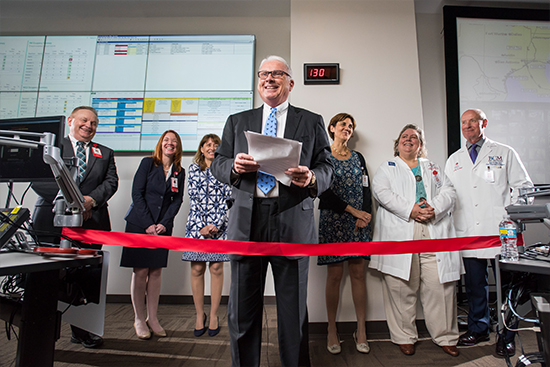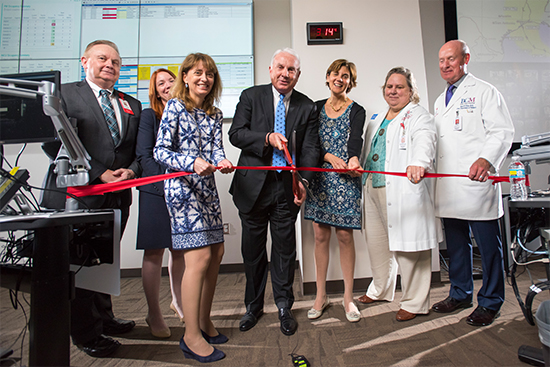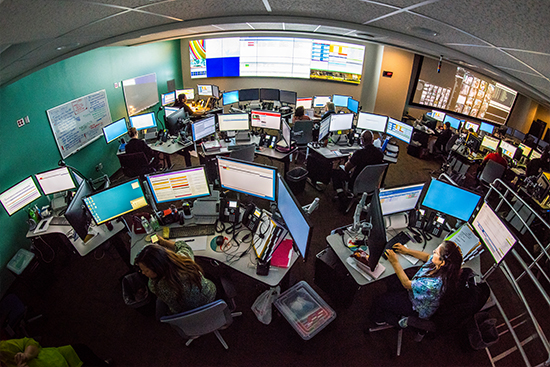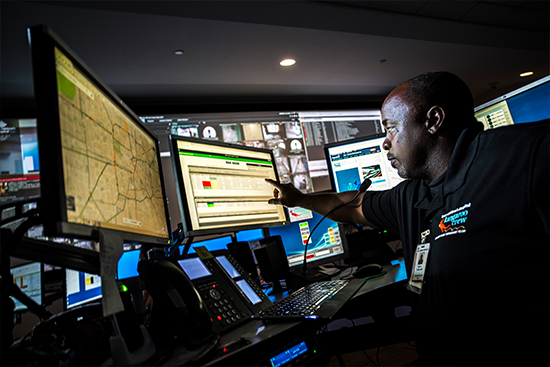Texas Children’s improves transfer process with opening of Mission Control
When a patient is transferred to or from Texas Children’s Hospital, several wheels are set into motion to make the process run smoothly for our patients and their families. People from various areas of the organization jump into action to make the best decision on where a patient needs to go and how they should get there.
For decades, the transfer process has prevailed using little to no technology to transfer an average of about 1,300 patients a year to and from Texas Children’s Hospital in the Medical Center, West Houston and The Woodlands. On April 19, 2017, all that changed with the opening of Texas Children’s Mission Control, a communications hub for everyone involved in the transfer process and beyond.
“This is another great day at Texas Children’s Hospital,” said Texas Children’s President and CEO Mark Wallace at the facility’s grand opening ceremony. “Mission Control is distinctive, innovative, forward thinking and a great example of the amazing leadership we have here at Texas Children’s.”
Mission Control is located in a large, high-tech suite on the third floor of Texas Children’s Pavilion for Women, housing representatives from the hospital’s Security and Facilities departments, Room Management, Transport Services and Critical Care.
When a call about a transfer comes into the center, representatives from all teams work together to ensure an efficient, rapid and accountable transfer occurs, and to provide the highest quality and safest care possible for Texas Children’s high-risk maternal, neonatal and pediatric population.
“We have all the people in the room we need,” said Deborah D’Ambrosio, director of Transport Services and Mission Control. “It’s so much easier to coordinate and be efficient and supportive to families in referring hospitals.”
One notable change following the opening of Mission Control was the splitting of responsibilities for transfers and transports. Transfer refers to the normal coming and going of patients, and transport refers to patients who are much sicker and need a physician or a higher level of care while being moved. At Mission Control, transfer calls go to one team and transport calls go to another. The team that handles the transport cases includes a transport charge nurse and a critical care physician.
“At Mission Control, you have one directive and no distractions from competing interests,” said Dr. Mona McPherson, medical director of Mission Control. “Your sole focus is on getting the patient where they need to be, safely and quickly.”
Integrating technology
In addition to the centralized location and more clearly defined responsibilities, the biggest change to Texas Children’s transfer process was the implementation of technology that helps everyone do their job better.
At Mission Control, each workstation has four monitors displaying vital information. There is a huge LED display at the front of the room showing a list of patients coming and going from Texas Children’s; the location of all Texas Children’s ambulances; activity at Texas Children's two (soon to be three) helipads; and census at each of Texas Children's three hospital campuses. And, there are several systems operating behind the scenes that connect everyone in the room with the most up-to-date information possible to make the best decision about routing patients.
“We’ve gone from using very little technology to using a lot in various ways, all to help us improve every patient's outcome,” said Melissa Witt, a registered nurse and a senior system analyst for Texas Children’s Information Services. “We’re already seeing good results.”
During the first month Mission Control was launched, the team reduced their time from dispatch to pick up by 20 minutes. It used to take the team 50 minutes to get out the door. Now it takes them 29 minutes. In addition, the number of transfers has gone up, breaking a record in May 2017 with 151, boosting the hospital’s total number of transfers for the year to about 1,600.
“We’ve had more than one community ER physician say, ‘Wow, this is the easiest I’ve ever been able to get a child into Texas Children’s,’” McPherson said. “And that really is our mission central here. We want to make people want to call us, not just because we’re good and give excellent care, but also because it’s really easy to get a patient in here.”
Expanded use
Since the launch of Mission Control, the transport process has been extended to high-risk expectant mothers, combining the expertise of the Kangaroo Crew with labor and delivery nurses who ride in the ambulance and provide specialty care to patients enroute to Texas Children’s Pavilion for Women. The first such transport occurred in December 2017.
In the future, Texas Children’s leaders expect Mission Control to be involved in much more than just transportation. Already, the technology has started being used to keep better track of where its patients are and where they are going in the organization’s ever-growing system. Soon, the information will enable leaders to identify trends in patient care and help staff decide where Texas Children’s might need to expand services and facilities in the future.
Eventually, leaders want to be able to use the data to form predictive analytics drawn from patient data and used to predict outcomes, such as the potential risk a specific patient or patient population might face. Having this data will help Texas Children’s identify – and possibly even prevent – potential patient flow issues.
Another benefit of Mission Control is that it may eventually be used to monitor patients remotely. Clinical staff in Mission Control will be able to help monitor high-risk patients, providing an extra set of expert eyes to help watch and assess a patient’s care. Overall, Mission Control aids Texas Children’s in providing information to the organization’s clinical staff so they can more efficiently and effectively care for patients.
In October 2017, the American Society for Healthcare Engineering of the American Hospital Association recognized Texas Children’s Mission Control with the Excellence in Healthcare Facility Management Award. This award is given to individuals and teams exemplifying how facility management teams work together to optimize the physical environment and improve patient care.




